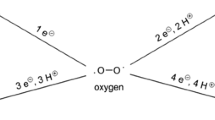Summary
Superoxide is considered to be poorly reactive, and cell damage has been attributed to HO· generated via the Haber-Weiss reaction. The function of O2 − in this reaction is only to reduce Fe3+ to Fe2+. In vivo, however, superoxide could not out-compete cellular reductants such as glutathione, NADPH, and ascorbate, which makes the observed O2 − toxicity rather puzzling. Little attention has been paid to the idea that, irrespective of its poor chemical reactivity, superoxide might be capable of interacting directly with specific intracellular targets; and that even the Haber-Weiss reaction might be a consequence of such direct interactions. This paper summarizes latest data that support the concept of such a mechanism.
Similar content being viewed by others
Abbreviations
- SOD:
-
Superoxide dismutase
References
Benov L, Fridovich I (1995) A superoxide dismutase mimic protects sodAsodB Escherichia coli against aerobic heating and stationary-phase death. Arch Biochem Biophys 322: 291–294
— — (1996) The rate of adaptive mutagenesis in Escherichia coli is enhanced by oxygen (superoxide). Mutat Res 357: 231–236
— — (1997) Superoxide imposes leakage of sulfite from Escherichia coli. Arch Biochem Biophys 347: 271–274
— — (1999) Why superoxide imposes an aromatic amino acid auxotrophy on Escherichia coli. J Biol Chem 12: 4202–4206
—, Kredich NM, Fridovich I (1996) The mechanism of the auxotrophy for sulfur-containing amino acids imposed upon Escherichia coli by superoxide. J Biol Chem 271: 21037–21040
Bielski BHJ, Richter HW (1977) A study of the superoxide radical chemistry by stopped-flow radiolysis and radiation-induced oxygen consumption. J Am Chem Soc 99: 3019–3323
—, Cabelli DE, Arudi RL (1985) Reactivity of HO2/O2 radicals in aqueous solutions. J Phys Chem Ref Data 14: 1041–1062
Carlioz A, Touati D (1986) Isolation of superoxide dismutase mutants in Escherichia coli: is superoxide dismutase necessary for aerobic life? EMBO J 5: 623–630
Czapski G, Golgstein S, Meyerstein D (1988) What is unique about superoxide toxicity as compared to other biological reductants: a hypothesis. Free Radic Res Commun 4: 231–236
Davies KJA, Lin WL (1988a) Degradation of oxidatively denatured proteins in Escherichia coli. Free Radic Biol Med 5: 215–223
— — (1988b) Oxidatively denatured proteins are degraded by an ATP-independent proteolytic pathway in Escherichia coli. Free Radic Biol Med 5: 225–236
DiGuiseppi J, Fridovich I (1984) The toxicology of molecular oxygen. Crit Rev Toxicol 12: 315–342
Dukan S, Nystrom T (1999) Oxidative stress defense and deterioration of growth-arrestedEscherichia coli cells. J Biol Chem 274: 26027–26032
Farr SB, D'Ari R, Touati D (1986) Oxygen-dependant mutagenesis in Escherichia coli lacking superoxide dismutase. Proc Natl Acad Sci USA 83: 8268–8272
Fee JA (1982) Is superoxide important in oxygen poisoning? Trends Biochem Sci 7: 84–86
Flint DH, Tuminello JF, Emptage NH (1993) The inactivation of Fe-S cluster containing hydrolyases by superoxide. J Biol Chem 268: 22369–22376
Gardner P, Fridovich I (1991a) Superoxide sensitivity of the Escherichia coli 6-phosphogluconate dehydratase. J Biol Chem 266: 1478–1483
— — (1991b) Superoxide sensitivity of the Escherichia coli aconitase. J Biol Chem 266: 19328–19333
Halliwell B (1978) Superoxide-dependant formation of hydroxyl radicals in the presence of iron chelates: is it a mechanism for hydroxyl radical production in biological systems? FEBS Lett 92: 321–326
Hausladen A, Fridovich I (1994) Superoxide and peroxynitrite inactivate aconitase, but nitric oxide does not. J Biol Chem 269: 29405–29408
Keyer K, Imlay J (1996) Superoxide accelerates DNA damage by elevating free-iron levels. Proc Natl Acad Sci USA 93: 13635–13640
Kuo CF, Mashino T, Fridovich I (1987) alpha,beta-Dihydroxyisovaleriate dehydratase: a superoxide-sensitive enzyme. J Biol Chem 262: 4724–4727
Liochev S (1996) The role of iron-sulfur clusters in in vivo hydroxyl radical production. Free Radic Res 25: 369–384
—, Fridovich I (1993) Modulation of the fumarases of Escherichia coli in response to oxidative stress. Arch Biochem Biophys 301: 379–384
— — (1994) The role of O2 − in the production of HO·: in vitro and in vivo. Free Radic Biol Med 16: 29–33
Maringanti S, Imlay J (1999) An intracellular iron chelator pleiotropically suppresses enzymatic and growth defects of superoxide dismutase-deflcient Escherichia coli. J Bacteriol 181: 3792–3802
McCord JM, Day ED (1978) Superoxide-dependant production of hydroxyl radical catalyzed by iron-EDTA complex. FEBS Lett 86: 139–142
—, Fridovich I (1969) Superoxide dismutase: an enzymatic function for erythrocuprein (hemocuprein). J Biol Chem 244: 6049–6055
McCord JM, Keele BB, Fridovich I (1971) An enzyme based theory of obligate anaerobiosis: the physiological function of superoxide dismutase. Proc Natl Acad Sci USA 68: 1024–1027
Sawyer DT, Valentine JS (1981) How super is superoxide? Accounts Chem Res 14: 393–400
Stadtman ER, Oliver CN (1991) Metal-catalyzed oxidation of proteins. J Biol Chem 266: 2005–2008
Winterbourn C (1981) Hydroxyl radical production in body fluids: roles of metal ions, ascorbate and superoxide. Biochem J 198: 125–131
— (1993) Superoxide as an intracellular sink. Free Radic Biol Med 14: 85–90
Author information
Authors and Affiliations
Rights and permissions
About this article
Cite this article
Benov, L. How superoxide radical damages the cell. Protoplasma 217, 33–36 (2001). https://doi.org/10.1007/BF01289410
Received:
Accepted:
Issue Date:
DOI: https://doi.org/10.1007/BF01289410




